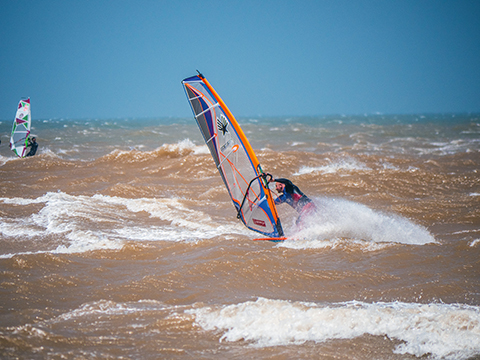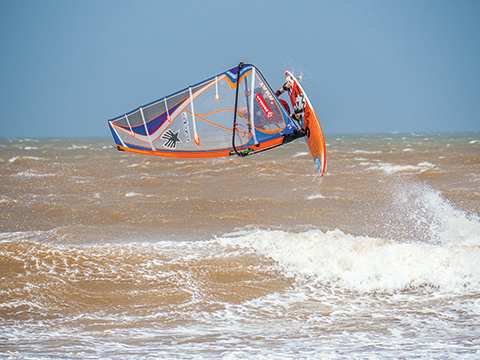JEM HALL
MOVE ON UP – WINDSURFING TECHNIQUE
SURFVIVAL
A relatively mild early winter accompanied by some big winds and waves has prompted this feature on how to cope with high wind sessions and tips for you to focus and reflect upon. A couple of areas that will be called strongly into account are your fundamentals and your fitness. So if you wish to really cope and perform in strong winds then ensure you are very fit and strong and that your stance and transitions are really on song. Remember that in very strong winds (4.0 to 2.9 sails), there is so much power coming from the rig that you really have to be ready for a battle and the rig will not feel as light as sailing in lighter winds as you are rarely sailing as fast as the wind speed! Lastly, any glitches in your basics will be found out, discovered and punished in stronger winds but fear not you can and you shall achieve and the tips herein will help you manage the strong wind challenge.
Words Jem Hall // Photo Clive Boden
www.jemhall.com
(This feature originally appeared in the March 2016 issue of Windsurf Magazine. To read more features like this first, Print and Digital subscriptions are available. Prices include delivery globally for 10 x issues a year!)
Putting together the parts to survive
I Mindset; it is perfectly natural and rational to be scared but you have to not let this fear lead to failure and go with the famous mantra of ‘feel the fear and do it anyway’ from Susan Jeffers.
• The chimp in your head will be saying all sorts of negative expressions but you must discount these and employ a positive self-dialogue. I use phrases like ‘I can do this,’ ‘I’m in control,’ ‘Pull down and get low’. These will be more powerful if you Smile and Breathe, sounds silly but this works both on the beach, and on the water.
Tuning; be ready and rig it right.
• I first place my board on the beach and either weight it down with rocks or embed it in the sand deep. This might not always be possible but it means less kit carrying when out of control with the strong winds blowing you around. If I have done this I get changed into my wet gear and get all my rig parts ready, i.e. the right length and positions. I will then lock up the vehicle so I can get straight to the water without putting my sail down after rigging up, and risk it blowing away.
• I suggest you know your small sail tuning already, and have the straps tuned for your winter boots if it is the first time you are in these.
• The small sails really love the right mast (340 or 370) so if you want to have the best from your rig then have the right components.
• If it is really howling then I have a lower boom.
• You will need enough power, and board, to get out through the break; better kit selection will come through experience.
• Get your harness lines in the right place to match the sail (and long enough). It is easy to oversheet small sails so ensure they are not too far back or apart! In general small sails require moving the harness lines forward of your normal position.
“ Push the rig away and pull the boom down! ”

Exaggerate your key actions, keeping the rig away and from a low body position for all your moves!
Starts; the wind has so much force in these strong winds that you really have to pay attention when getting up and out of the water. You will also have to scan out to sea for squalls that are coming and for the sets. Time your launch just as the last waves of a bigger set are breaking.
• Beach starts should actually begin with laying back in chest depth water, and more akin to a waterstart. This avoids an unnecessary catapult on your first foray!
• Strangely enough waterstarts actually get harder in strong winds, with the lift in excess of what is needed. Aim to really control the rig once you have cleared it from a low position by looking and pointing the nose slightly upwind as you feather the sail whilst waiting to come up, and concentrate!
• To come up really use your legs, whilst throwing the rig upright, and do less sheeting in. Sheet out once up, look upwind, and feel the mantra ‘come up slow and stay low’.
Stance; Getting going and sailing in strong winds will see any bad habits severely punished so you have to be efficient, aggressive and really planning ahead.
• To get going you really have to pull down on the boom and match it with a very bent back leg. Really bear away to get moving quick and early to get the sail light and I strongly advocate both straps before hooking in. Once you have some speed the sail will lighten up and it will be much easier to hook in. You can then choose your route out.
• Scan ahead for big gusts and lulls, waves and anticipate as oppose to reacting. If it is really windy then when you are really powered up you may have to bear away a lot in the lulls in order to keep downwind!
• Your straight-line mantra is ‘get down James Brown and pull down.’ Drop your arse and really drop your elbows to pull the kit into the water.
• You can actually sail without fully sheeting in during huge gusts, as long as you really pull down on the boom, you often don’t need all that power from the wind! I call this throttling off.
• Remember to also straighten your arms and lift your hips in anticipation of lighter lulls and avoiding the ever so easy oversheeting as the wind drops a bit.
• You have to really focus when blasting and cannot switch off for a second so be on your game and get off the water for a break if you are getting mentally / physically tired.
• Look to do short reaches, so you are not going out to the really strong winds out the back and sailing safely.
Transitions; my most important tip is to believe that you will make them! Positive self-dialogue is paramount here.
• Even though getting upwind is easy when overpowered, your tacking skills are very handy. Using chicken tacks to avoid going over bigger sets, and being able to avoid gybing in Armageddon gusts, is strongly advised.
• Gybing in strong winds is challenging and in the less crazy gusts you may have to do wider gybes to actually get downwind!
• The layback gybe is a very useful move where from a low body position and your weight to the inside of the gybe you give the back hand a big oversheet to stall the sail as you carve off the rail and follow with a quick step, and then rig change.

‘Throwing a forward; take your opportunities to do some moves when the conditions allow’
The water is bumpy so you have to use the ocean. Look to gybe after getting over the first waves of the set, and if your timing is good then gybe off a wave. The inside is often flat and less windy so here you just need to give yourself enough space and time to gybe.
• In all your transitions exaggerate the key moves and prepare from a low position and get your hands in the right place on the boom.
• When exiting moves be really low with good vision and get into the straps before hooking in.
• You are looking to push the rig away and not pull it in, BUT in this process you also have to pull the boom down!
Jumping; this is a whole article in itself so I will give you a few quick tips here.
• You will really want to be cautious and jump into the wind, but you must resist this urge and jump across the wind to get better flight and keep speed.
• Get the sail light with good board speed
pre-jump. In the air get rig back and rail up (toes down).
• Hold up your tail for a long time, and keep compact in the air.
• Have fun and really look to boost big old-fashioned rocket airs.
• If forward loops are your thing then really steer round the loops (using your legs and the rig) not sheet round them. This avoids those painful endover crashes.
• Push loops can be easier when well powered and back loops need a lot of control and a slow, later rotation.
• Look to squeeze the best out of conditions, it may feel like you are always out of control, yet when that lull comes you have to go for the moves.
Riding; again there are so many tips for this in mental winds but here are the best ones.
• Backside riding can be easier in side/side on winds as you are turning upwind when you have your most speed.
• Frontside turns need to be short tighter turns off the back foot, to ease excessive speed, whilst you throw the rig open and get your body low and back.
• Really use the wave so you keep speed and have a clean face to ride.
• Only the bigger sets will be rideable, the smaller waves will be chopped up by the wind.
• Take the last or penultimate wave in the set.
• Have a plan and execute it whilst thinking ahead in minutes and batches of 200 metres.
• Get low; be precise and exaggerated in your head and hand movements.
Get out there and attack, you just won’t know until you go!
“ Feel the fear and do it anyway! ”
RRD boards, wetsuits, softwear, Ezzy sails sponsor Jem Hall. Get him live and direct on one of his highly acclaimed coaching holidays but be quick as they are selling out – check out his fab new site www.jemhall.com for details. You can also follow him on twitter / Facebook / Instagram..
www.jemhall.com


